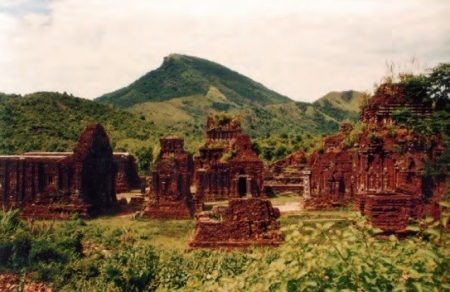My Son is in a narrow, isolated valley about one and one-quarter miles in diameter, surrounded by a range of high mountains. The sanctuary is located under the foot of the holy mountain of Mahaparvata (Great God of the Mountain, or the god Shiva). A stream originating there flows north through the site to join the Thu Bon river, the holy river of Mahanadi (the goddess Ganga, a consort of Shiva).
The first wooden temple to Shiva was built at My Son at the end of the fourth century by King Bhadravarman (c. 384–413), named in an inscription found at the site. My Son includes sixty-eight temple towers of brick and sandstone,
Iconographically, the Hindu temples at My Son demonstrate the unique cult and cosmological concept of Cham royalty, in which the Shivaite cult is represented in the worship of the phallic linga and a statue of Shiva in human form side by side. The worship of Shiva at My Son, together with the worship of the goddess Bhagavati, a consort of Shiva, at Po Nagar Nha Trang (another royal sanctuary of the southern state of the kingdom approximately 310 miles from My Son), reflects the dual cosmology—male-female / father-mother / mountain-sea / areca clan–coconut clan, and so on—of the cult practiced at the two royal sanctuaries throughout the Cham dynasties from the eighth to the thirteenth century. This cosmological dualism, which was rooted in the natural beliefs of the prehistoric Austronesian world, survives to this day in the Cham ethnic community.
According to Chinese historical records, the Champa kingdom was established at the end of the second century CE (c. 192). Because of their strategic location along the coast of what is now central Vietnam, the Champa became middlemen in both overland and sea trade between East and South Asia as well as the Hinduized states of Southeast Asia. The Cham occupied estuaries to build well-located ports that were active in the South China Sea trade route. The rich forest resources of this land also made Champa prosperous; for centuries the Cham exported luxury products such as eaglewood, cinnamon, rhinoceros horn, ivory, rare animals, and spices to Arabian and Chinese merchants.
As a result of trade interaction with the Javanese and Khmer from the tenth century onward, the Cham adapted the cults of
From the point of view of art history, each work of Hindu art in Southeast Asia formed its own characteristics from the typical artistic vocabularies of localized Hindu traditional art of the Indian subcontinent. Significantly, from the eighth century onward, when the economics of the region fully developed through engagement in maritime trade, these ancient states lost their direct connections with those artistic traditions. Southeast Asian arts then had to rely on
Members' Research Report Archive
Iconographical Features of the My Son Sanctuary: The Cham Art of Vietnam and Its Relationship with Javanese and Cambodian Art
Tran Ky Phuong, Vietnam Association of Ethnic Minorities’ Culture and Arts
Ailsa Mellon Bruce Visiting Senior Fellow, June 21–August 22, 2012
The significant features of Cham art, one of the earliest Hinduized arts in Southeast Asia, were well represented in the Cham royal sanctuary, known today as My Son. Located in My Son village in Quang Nam province, approximately forty-three miles southwest of Danang, Vietnam, this religious architectural site was rediscovered during the French colonial period, in 1885. Because of My Son’s unique historical and architectural value, it was listed as a World Cultural Heritage site by UNESCO in December 1999.

Brick temples with the holy mountain Mahaparvata in the background, My Son Sanctuary, seventh to thirteenth century, Quang Nam province, Vietnam. Author photograph